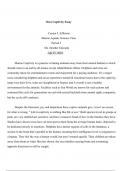Orca Captivity Essay
Ceniya J. Jefferson
Marine Aquatic Science Class
Period 3
Ms. Heather Edwards
Apr 25, 2022
Marine Captivity is a practice of taking animals away from their natural habitat to which
should come to an end by all means except rehabilitation efforts. Dolphins and orcas are
commonly taken for entertainment events and enjoyment for a paying audience. It’s a major
issue considering dolphins and orcas experience mental & emotional issues due to the captivity,
many lose their lives, some are slaughtered or beaten, and it overall is not a healthy
environment for the animals. Facilities such as Sea World are known for such actions and
continued the cycle for generations on end with crucial backlash from animal rights companies,
but the cycle still continues.
Despite the functions, joy, and inspiration these captive animals give, it isn’t an excuse
for what is wrong. “ Life in captivity is nothing like life at sea.” Both species travel in groups or
pods, are very intellectual, sensitive, and have a massive bond of love in the families they have.
Studies have shown orcas have an extra part in their brain the average human lacks, depicted to
be dedicated strictly to emotions. Dolphins have denser regions of cells in the thalamus, a
section in the brain that’s parallel to the human, meaning their intelligence level is congruent to
a human. They feel the way a human would, but aren’t treated equally. Their children are taken
away from them as video film has shown, the orca families sensing boats and swimming
opposite directions to still be caught.
, Film and reports also caught wind of mothers experiencing high levels of depression,
stress, isolation, and self sabotage while some children, during that moment, scream & whale
from the horrors of heartbreak on both sides. Dolphins & orcas can have abnormalities and
mental disorders, as it's common in complex animals. “They can experience self harm, hyper
aggression, depressive behaviors, and failures in nursing and parent offspring attachment.”
Such behaviors are not just at sea in the midst of capture, but highly in captivity. Marine
parks across the globe insist on separating offspring from their mothers due to how much they
sell for and the size/vulnerability of the young being what money & entertainment companies
are looking for. Morally, the only time when “ separation was allegedly understandable was
when mothers of young become violent because of their inexperience & require superior
medical care at a different captivity site.” The facilities damage and lead to the death of both
species despite any modification efforts put in place from the number of incidents & deaths that
have occurred.
“ Loud noises from the places themselves to loud crowds cause massive stress for both
species, leading to psychological distress and emotional disturbance.” It includes stereotypical
behavior, unresponsiveness, excessive submissiveness, self-inflicted physical trauma &
mutilation. Continuing, a difference can be seen between one’s original habitat versus a false
depiction. “ Wild cetaceans travel 40-100 miles a day, achieving speeds of 30 miles per hour
(ca. 48 km/h), and a dive hundreds of feet deep. Even in large facilities, they have less than
.0001% of their natural habitat range.” Captive marine mammals suffer from several health
problems too, which are mainly neurotic. For example, bottlenose dolphins are six times more
likely to die after capture from the wild than transferring to a tank. As of recent times about
3,000 dolphins are taken for captivity while the statistics for orcas are continuously declining.
The counter-offs believe “ captivity enables showcases for the public, brings people from
all around the world together to enjoy such sites, & inspires children and or opens up
opportunities for aquatic jobs in the future.” Following, there has been no recent incidents
revolving to captive orcas, and facilities can provide rehabilitation for endangered species.
Companies like Sea World are also beneficial. Some evidence proves for dolphins that while
held in captivity, training based on natural behaviors can lead to improved welfare.




